External links
- Catalogue entry for Auctores Octo cum Commentario of 1494 does not work
- Auctores Octo Morales full book on Google Books
The Auctores octo morales (Eight Moral Authors) was a collection of Latin textbooks, of an elementary standard, that was used for pedagogy in the Middle Ages in Europe. It was printed in many editions, from the end of the fifteenth century. At that time it became standardised as:

Fable is a literary genre defined as a succinct fictional story, in prose or verse, that features animals, legendary creatures, plants, inanimate objects, or forces of nature that are anthropomorphized, and that illustrates or leads to a particular moral lesson, which may at the end be added explicitly as a concise maxim or saying.

Gaius Julius Phaedrus, or Phaeder was a 1st-century AD Roman fabulist and the first versifier of a collection of Aesop's fables into Latin. Nothing is recorded of his life except for what can be inferred from his poems, and there was little mention of his work during late antiquity. It was not until the discovery of a few imperfect manuscripts during and following the Renaissance that his importance emerged, both as an author and in the transmission of the fables.

Aesop's Fables, or the Aesopica, is a collection of fables credited to Aesop, a slave and storyteller who lived in ancient Greece between 620 and 564 BCE. Of varied and unclear origins, the stories associated with his name have descended to modern times through a number of sources and continue to be reinterpreted in different verbal registers and in popular as well as artistic media.
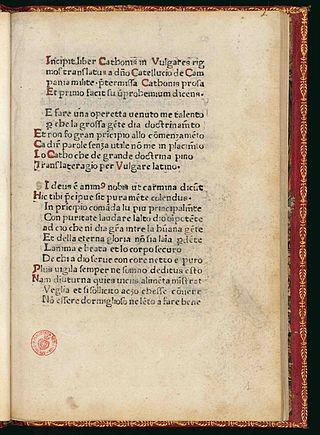
The Distichs of Cato, is a Latin collection of proverbial wisdom and morality by an unknown author from the 3rd or 4th century AD. The Cato was the most popular medieval schoolbook for teaching Latin, prized not only as a Latin textbook, but as a moral compass. Cato was in common use as a Latin teaching aid as late as the 18th century, used by Benjamin Franklin. It was one of the best-known books in the Middle Ages and was translated into many languages.

The Monkey and the Cat is best known as a fable adapted by Jean de La Fontaine under the title Le Singe et le Chat that appeared in the second collection of his Fables in 1679 (IX.17). It is the source of popular idioms in both English and French, with the general meaning of being the dupe of another.
Bernard of Utrecht was a cleric of the late eleventh century, known for an allegorical commentary on the Eclogue of Theodulus, a standard Latin school text. According to its modern editor R. B. C. Huyghens, in it "students of the history of medicine will find the earliest mention of autopsy, philosophers the oldest quotation from the "Florentina," the Latin version of Aristotle's "Analytica priora", and historians the oldest version of the malicious story of the pact between the devil and pope Sylvester II."

Zeus and the Tortoise appears among Aesop’s Fables and explains how the tortoise got her shell. It is numbered 106 in the Perry Index. From it derives the proverbial sentiment that ‘There’s no place like home’.

Belling the Cat is a fable also known under the titles The Bell and the Cat and The Mice in Council. In the story, a group of mice agree to attach a bell to a cat's neck to warn of its approach in the future, but they fail to find a volunteer to perform the job. The term has become an idiom describing a group of persons, each agreeing to perform an impossibly difficult task under the misapprehension that someone else will be chosen to run the risks and endure the hardship of actual accomplishment.
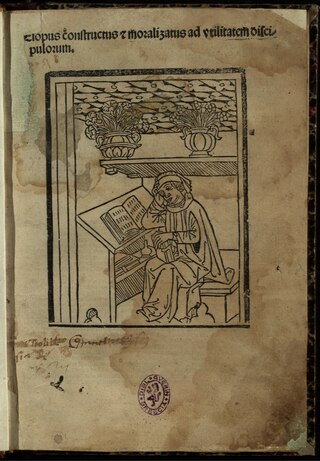
Gualterus Anglicus was an Anglo-Norman poet and scribe who produced a seminal version of Aesop's Fables around the year 1175.
Romulus is the author, now considered a legendary figure, of versions of Aesop's Fables in Latin. These were passed down in Western Europe, and became important school texts, for early education. Romulus is supposed to have lived in the 5th century.

Aesop is an almost certainly legendary Greek fabulist and storyteller, said to have lived c. 620–564 BCE, and credited with a number of fables now collectively known as Aesop's Fables. Although his existence remains unclear and no writings by him survive, numerous tales credited to him were gathered across the centuries and in many languages in a storytelling tradition that continues to this day. Many of the tales associated with him are characterized by anthropomorphic animal characters.
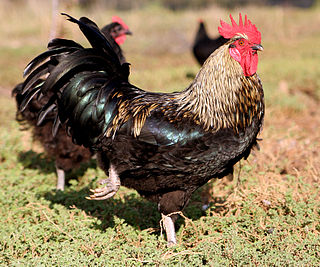
The Cock and the Jewel is a fable attributed to Aesop and is numbered 503 in the Perry Index. As a trope in literature, the fable is reminiscent of stories used in Zen such as the kōan. It presents, in effect, a riddle on relative values and is capable of different interpretations, depending on the point of view from which it is regarded.

Speaking of The Snake and the Crab in Ancient Greece was the equivalent of the modern idiom, 'Pot calling the kettle black'. A fable attributed to Aesop was eventually created about the two creatures and later still yet another fable concerning a crab and its offspring was developed to make the same point.

The Dog and the Wolf is one of Aesop's Fables, numbered 346 in the Perry Index. It has been popular since antiquity as an object lesson of how freedom should not be exchanged for comfort or financial gain. An alternative fable with the same moral concerning different animals is less well known.
The Fox and the Woodman is a cautionary story against hypocrisy included among Aesop's Fables and is numbered 22 in the Perry Index. Although the same basic plot recurs, different versions have included a variety of participants.
The Old Man and Death is one of Aesop's Fables and is numbered 60 in the Perry Index. Because this was one of the comparatively rare fables featuring humans, it was the subject of many paintings, especially in France, where Jean de la Fontaine's adaptation had made it popular.

Hercules and the Wagoner or Hercules and the Carter is a fable credited to Aesop. It is associated with the proverb "God helps those who help themselves", variations on which are found in other ancient Greek authors.
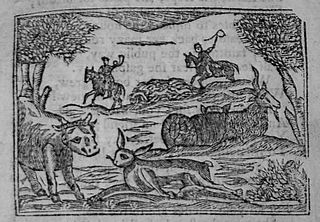
"The Hare and many friends" was the final fable in John Gay's first collection of 1727. It concerns the inconstancy of friendship as exemplified by a hare that lives on friendly terms with the farm animals. When the horns of the hunt are heard, she panics and eventually collapses exhausted, begging each of her acquaintances to help her escape. All give her different excuses, the last being a "trotting calf" who bids her "Adieu" as the hunters burst onto the scene. The poem won widespread popularity for some 150 years afterwards but, on a prose version appearing in a collection of Aesop's Fables, Gay's original authorship has gradually become forgotten.
The Old English Dicts of Cato is the editorial name given to the Old English language text based on the Latin Distichs of Cato. It is a collection of approximately 80 prose proverbs, the exact number varying between each of the three manuscript versions. These can be found in MS Cambridge, Trinity College, R.9.17, MS British Library, Cotton Vespasian D.xiv and MS British Library, Cotton Julius A.ii respectively.
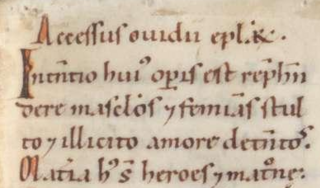
The accessus ad auctores was a literary genre of the Middle Ages. Originally, an accessus was the introduction at the beginning of a commentary on a classical author, containing background information on the author and his work. Beginning in the 12th century, these accessus were excerpted from the commentaries and published in separate collections. It is to these collections that modern scholars give the name accessus ad auctores. Invariably written in Latin, they were designed for the use of students of Latin grammar.